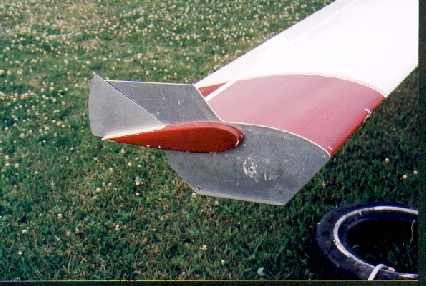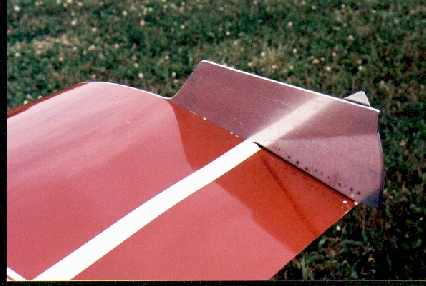
HP-14 Wing Fences
By
John de Jong
Ours is only one of two HP14ís at my home airfield, and this past winter my partner and I decided to give a try an idea that the otherís owner (Calvin Devries HP14 s/n#13 CF-ALT) had used on his aircraft. According to him there is a considerable cross-flow problem on the wing tips of the Ď14, which reduces the effective width of the ailerons by a couple of feet. Because of this his HP14 had very poor roll rate (and all HP14ís in general suffer from this Iím told). His solution was to remove the existing tip plates from the wings, and put new ones on with the same general shape as most current "winglets". According to him, he saw a considerable improvement in roll rate, and a reduction in stall speed of nearly 5 kts.
His "winglets" ended up being ~ 12" high above the wing surface. When we started doing a little investigation about this on the Ďnet, and with some people we know (aeronautical engineers and various homebuilders) we found an interesting problem with adding a stall fence though. Anything more than a couple of inches high will add to induced drag, without improving airflows at the wingtip.

As such, we decided to make our fences max ~3" high above the wing upper surface. At the same time we decided to lower the "skid" portion since the way our ship was built, if one lands with full flap when a wing settles the flaps were dragging on the ground. This cause grass to be being driven under the paint/filler that was there, and the metal was slowly getting ground off.
So, with a little 1/8" plate Aluminum, and a lot of elbow grease I fabricated the fences that you see in the photos. The fence has to be angled back from the trailing edge to allow aileron movement, and a small sheet metal wiper has to be riveted onto the aileron end/counterbalance to finish the "seal".
The "winglets" appear to work well for us, the skid being lowered now protects the flaps, and our roll rate "feels" better. Unfortunately I didnít do any quantitative tests late last year on roll rate, but I would estimate that now we have 45 to 45 degrees at ~55kts in less than 4 seconds. Not too bad. Also, our stall speed is definitely lower, by I would guess 3-5 kts. Unfortunately due to our ship having a tail mounted pitot tube (yep, on the V tail) when below about 37kts we get a lot of turbulence hitting the pitot.

Before the change, we would stall very shortly after the airspeed started bouncing, and without raising the nose much more. Now, we can raise the nose considerable higher after the airspeed starts to bounce, and the stall is much longer in coming. We also have noticed a big improvement in thermalling. Before in turbulent thermals we would fly at ~50-55kts because the ship handled poorly, now we can slow up to 45 kts without any problems.
All in all I found that for a bit of effort, and very little money for materials a pretty large improvement can be made in your HP14ís low speed performance. High speed performance for us has not shown any apparent change in any speed up to 120kts, but we havenít done any comparative testing.